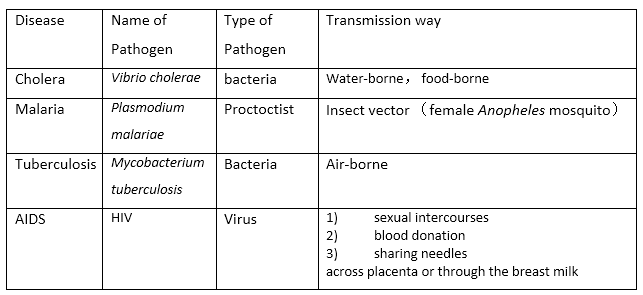来源:环球教育
小编:长安 59A-level生物考试中有这么一类题,总是让我们挠破头皮:它有着大量的生僻词汇,有着晦涩新颖的题型。它就是与传染疾病(infectious diseases)相关的题。今天我们就一起攻破这道防线,打上对传染疾病题的免疫疫苗:
首先,A-level大纲中所涉及到的传染类疾病有四大疾病,最基本的你要清晰各个疾病的Pathogen(病原体,病原体的类型)和transmission way(传播途径)。

其次,根据不同疾病的特点,分析其在全球范围内的分布情况(global distribution)。这里答题时要注意这几个单词的区别,尤其是选择题要特别小心:endemic(diseases that are always in populations. For example: TB is endemic in the whole human population while malaria is endemic in tropical and sub-tropic.), epidemic (there is a sudden increase in the number of people with a disease.) and pandemic ( there is an increase in the number of cases throughout a continent or across the world.)。总的来说关于疾病的分布可以分成两大类:worldwide(全球)和endemic in some countries(部分国家):
1)全球分布的疾病有TB和AIDS,他们都有一个特征是他们都有long incubation period(长的潜伏期)加上贸易交流全球化,这就保证了infected people在不知道病情的情况下,带着病原体去到别的国家,将病原体传播出去。
2)局部分布:
a)cholera:contaminated water(被病原体污染的水)是cholera传播的关键环节,所以该疾病的传播主要区域即没有好的卫生条件(poor sanitation),无法进行有效 污水处理(no sewage treatment)的贫困地区, 例如Africa,Asia, Latin American。
b)malaria:female Anopheles mosquito是malaria传播的关键,它的生长繁殖需要一个温暖潮湿的环境(warm and moist),所以在热带(tropic)及亚热带(sub-tropic)特别盛行。
c)TB:TB虽然在全球范围内有,但是因为它是air-borne,所以在人口密集(large population)及没有好的住房保障(homeless)的区域特别突出。
经过梳理,你对传染疾病这章的基本内容有没有更清晰的认知了呢?下次,环球教育还将对这章的重难点传染疾病的预防、控制及根除面临的困难进行进一步讨论,尽请期待!